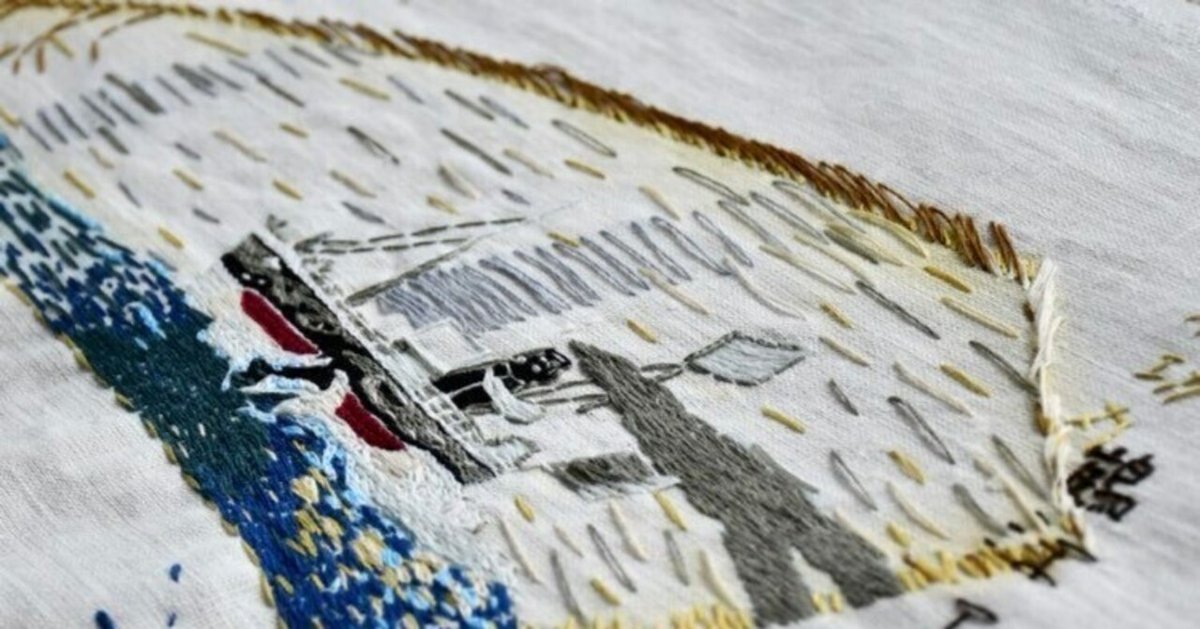
P.12|ノルウェーと日本の間、ある船の記憶をたぐる / Drawing a memory of a ship between Norway and Japan


(English follows.)
ノルウェーに来てから半年が過ぎました。滞在の折り返し地点です。4月下旬からオスロにて最初の展示を行います。会場はオスロ大学図書館の展示スペースです。こちらで参加している研究プロジェクト「Whales of Power」との展示です。 ここ半年ほど手繰っていた物と語りを紹介します。
----------
それは一枚のガラスネガから始まった。撮影者はヘンリク・G・メルソム。1900年前後に日本の捕鯨船で活躍したノルウェー人砲手だ。20世紀初頭、ノルウェーから日本へ「ノルウェー式捕鯨」が導入された。捕鯨砲を用いるノルウェー式捕鯨の発明は捕鯨技術に大きな進歩をもたらした。メルソムのガラスネガには当時の捕鯨船と捕鯨事業所の様子、アジアとヨーロッパ各地を訪問した旅の様子、故郷の家族の姿が残されている。
この時代、日本国内で網取式捕鯨を伝統としてきた各地の担い手たちも新たな捕鯨産業の労働力となっていった。生活と文化の礎であった鯨は、資本主義経済の始まりとともに各国が捕獲を競う資源へと移り変わっていった。鯨との関わりとともに人々の自然観が大きく変化したこの時代の記憶をノルウェーと日本に残る記録や物質文化に見出せないだろうかと考え始めた。絡まる糸のような捕鯨の記憶を解いていくように。
メルソムのガラスネガに捕鯨船上から撮影された一枚があった。仕留めた鯨を船の横に牽引している。船名は不明だが、救命浮輪に「SHIN…」という文字が覗いていた。船名の一部のようだ。ノルウェーの博物館で捕鯨に関わる資料を見ながら、日本と共通する物、よく似た物の存在に興味を持っていた。例えば、長い航海の間にマッコウクジラの歯を彫って作られたペンギンの置物や捕鯨船を描いた鯨のヒゲ板だ。ノルウェーから伝わった鯨骨(顎骨や肋骨)のアーチが、日本の捕鯨に関わる土地では神社の鳥居として使われたという、移ろいのエピソードも頭の隅にあった。
いくつものヒントが重なり合って芽生えた直感のようなものだったのかもしれない。日本の捕鯨船乗りが鯨のヒゲ板に絵を描いたなら、ノルウェーで用いられた装飾品としてだけではなく、神社に奉納したのではないだろうか?と想像した。各地の博物館や捕鯨船乗りのものづくりに詳しい人たちに尋ねながら調べをすすめ、いくつか絵馬として使われた鯨ヒゲが見つかった。そして、山口県萩市のある神社に奉納された絵馬に行き当たった。 描かれた船の名は「神功丸」。ローマ字読みにすると「SHINKOMARU」。1900年代初頭に奉納されたと考えられ、操業年とも重なる。ノルウェー人砲手・メルソムのガラスネガに写った捕鯨船は、当時「クリスチャニア」だったオスロで建造され日本に渡った捕鯨船、「神功丸」だったと考えられる。そして神功丸が描かれた鯨ヒゲ絵馬が残る山口県萩市は、19世紀の終わりにノルウェーを訪れ捕鯨技術を学び、日本にノルウェー式捕鯨を伝えた人物、岡十郎の故郷だった。長州・山口県では伝統的な捕鯨の時代が終わり、近代捕鯨が始まった。
ノルウェーと日本のガラスネガと絵馬に記録された一隻の船を縁に、それぞれの土地に残された語りを縫いとっている。萩博物館と情報交換をしながら知った鯨との関わりの歴史、水田の害虫駆除に用いられた鯨油とかつての伝統捕鯨、今なお残る節分に鯨を食べる風習。メルソム氏の子孫を訪ねて聞いた家族の歴史、日本からもたらされた品々の逸話、捕鯨の記憶。
一枚の長い長い布の上に双方の土地の記録を縫い取っていく。糸が描く絵と絵のあわいが混じり合う時、海原を越えて離れ離れになっていた記憶が結びついていくようだ。
----------
展覧会のオープニングは4月25日、トークもあります。
Exhibition opening: Whales of Power
https://www.ub.uio.no/kurs-arrangement/arrangementer/uhs/2023/utstillingsapning-whales-of-power.html


I am delighted to announce the exhibition at HumSam-biblioteket, University of Oslo. This will be a combined exhibition of art and research with the research project "Whales of Power".
I would like to introduce stories behind the new embroidery work I will show at the exhibition, which has been my focus for the past half year.
----------
It began with a glass negative. The image was captured by Henrik Govenius Melsom, a Norwegian gunner who served on board Japanese whaling ships around 1900. The "Norwegian system of whaling" was introduced to Japan from Norway in the early twentieth century. The invention of the Norwegian system of whaling using grenade harpoon guns brought great advances in whaling technology. Melsom's glass negatives show whaling ships and whaling stations of the era, his travels throughout Asia and Europe, and his family in Norway.
During that time, local whalers in Japan who had traditionally practiced whaling by nets became laborers for the new whaling industry. Whales that formed the lives and culture of the locals became a resource to be competed for catch among several countries, at the same time in the introduction of the capitalist economy.
It was the time when people's views of nature changed drastically in their relationship with whales. I began to wonder if I could find a trace of the people's minds of this era in the records and material culture that remain in Norway and Japan as if untieing the tangled memories with whales.
One of Melsom's glass negatives was taken onboard a whaling ship. A whale caught was being towed to the side of the ship. The ship's name was unknown, while the letters "SHIN..." could be recognized on a lifebuoy. The letters seem to be a part of the ship's name.
Observing materials related to whaling at museums in Norway, I also became interested in objects that are common or similar to things found in Japan. For instance, penguins carved from sperm whale teeth and painted whale baleen with images of whaling ships were created by Norwegian and Japanese whalers during their voyages, respectively. The study on the whale bone arches introduced by the Western society and transformed into whale bone torii (a shrine gate) in Shinto shrines in Japan was also in my mind.
It may have been a kind of intuition that grew from the experiences. I began to think that if Japanese whalers painted whale baleen, they might have dedicated the baleen to shrines, not only as ornaments like used in Norway. As I contacted museums and researchers, I found some examples of baleen paintings dedicated to shrines as "ema" (votive paintings). Among them, I encountered an ema dedicated to a shrine in Hagi, Yamaguchi, in Japan. The whaling ship depicted on the ema was "Shinkomaru." It is thought to be from the early 1900s. The whaling ship captured on the glass negative by the Norwegian gunner Melsom would have been the same ship depicted on the ema. It was a whaling ship built in Oslo, or the city of Kristiania at the time, and transferred to Japan.
Hagi of Yamaguchi is the birthplace of Juro Oka, who traveled to Norway at the end of the nineteenth century to study the Norwegian whaling system. This ema's dedication took place when the traditional whaling ended, and the modern whaling industry began in Japan.
I have been embroidering the narratives left in Norway and Japan over the unique ship Shinkomaru, as a glass negative and votive painting on whale baleen. During the process of creation, I learned the history and relationship with whales around the Hagi area, including the use of whale oil to exterminate harmful insects on rice fields and the tradition of eating whales on a special occasion of the Setsubun celebration that continues today. I visited Melsom's descendants, heard their family history and memory, and observed the goods brought from Japan.
The memories and histories of the two lands are stitched on a long piece of textile. As my stitches began to depict images and overlap, the separated memories seem to come together.
----------
The exhibition opening is on the 25th April. We will have short presentations, followed by Q&A, light refreshments and a tour of the exhibition!
https://www.ub.uio.no/kurs-arrangement/arrangementer/uhs/2023/utstillingsapning-whales-of-power.html
よろしければサポートをお願いいたします。いただいたサポートは、今後のリトルプレス『ありふれたくじら』の制作活動資金といたします。
